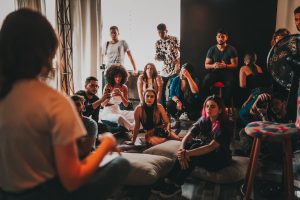Module 2: Expanding Your Intercultural Knowledge
Embracing Intercultural Knowledge
Expanding your intercultural knowledge can take different forms, but the key to any of them is personal engagement. No one can really learn about people’s experiences and expand their thinking if this is limited to reading or hearing about other people from someone else.
The following three sections explain how you can embrace and thus expand your intercultural knowledge. Make sure to do something from each section to ensure you have different forms and sources of information and interactions.
1. Engagement
Regardless of the extent to which you can make connections, or how comfortable you feel interacting with people, you can always make the best of the opportunities you have for engagement. Here are some things you can try:

- Reach out to people you have met before that are from different backgrounds. Have more conversations about the way they think and how they see your culture. Find out about their perceptions and preferences beyond tangible elements of culture. You may be surprised by how similar your views are, but even if they are different, remember that understanding different points of view does not equal agreement; it means you have a better idea of why people think and act in a certain way.

- Start a conversation with students, peers, or co-workers outside of your regular circle. Perhaps they could be from a different cultural group (whether they are domestic or international peers). Remember to suspend judgement by checking your biases and stereotypes.

- Do not sit away from people who seem to “look” different from you because you never know what you may have in common; this is a chance you have to learn about a different way of doing things from that person. Small changes in your actions can translate to great changes in the way you engage with others and can help you deconstruct stereotypes and expand your worldview.

- Take a look around your community. Even if it is heterogeneous, there may be people from different countries or with multicultural backgrounds. Make sure to engage with people from your own and a different group to learn about your cultural self as well as the experiences and stories of other people. You would be surprised by how enriching this experience can be for everyone.

- Join a club at the university and attend cultural events open to the public. Creating these opportunities to meet people will go a long way; it does not take a great effort other than wanting to connect with others while keeping an open mind.
Activity: Engaging with others
As you consider how you engage with others, would you say the following statements are true or false?
2. Relatability
Intercultural learning is not centred around differences; it is instead focused on understanding how our cultural identities interact within the same context. When we learn about other cultures, we observe similarities and differences across groups, but that is only a portion of our identity. We can relate to others based on, for example, our cultural background, opinions on issues, individual experiences, intersectional identities, and life histories.

- When studying a topic related to your program that really interests you, find a way to expand your interest by looking at the topic from the perspective of another culture or country. Take a moment to ask yourself, for example, what do engineers consider when building bridges in Guyana, Australia, or Portugal? How do people in rural areas of Guatemala see traditional versus modern medicine? How is physical activity promoted in Chinese cities? What lessons in international development can we learn from Denmark?

- Think about worldly or local events—something that is currently in the news. Focus on learning about how this looks from other perspectives and gaining an understanding of why or how people address the issue in a similar or different way. What does that mean for the population? How is that different from your own case? For example, consider the COVID-19 pandemic: How has this impacted rural or racialized people around you? What is the current situation in other countries? What do you know about how your East Asian friends feel when there is news of anti-Asian racism? What can you do?

- Reflect on the multiple layers of your identity. Perhaps there are aspects of your identity that are not easy to discuss or celebrate with people close to you. Think about how this may look for cultural others; this may be an opportunity to come together and share experiences, perspectives, seek support, and help each other thrive. Sometimes those who understand us best are not in our immediate surroundings because our views or ways of being may not agree. However, it is likely you will find other people with similar views across cultural lines; just because someone is from a different culture does not mean they do not share a similar experience to you.
Activity: Relating to Others
As you consider how you relate to others, would you say the following statements are true or false?
3. Intentionality
It is important to make a conscious effort to observe, listen, converse, interact, learn, share, and appreciate people, their stories, and their cultural background. It is very likely you have already had opportunities to expand your intercultural knowledge, but from now on, you can be more intentional about how to approach those opportunities.
Activity: Being Intentional
As you consider how to be more intentional, would you say the following statements are true or false?
Take away points
- There are different ways to connect and increase your intercultural knowledge.
- You can expand your intercultural knowledge through engagement, relatability, and intentionality.
- Engagement involves interacting with people from different cultural backgrounds, connecting with people with whom you do not usually interact, immersing yourself deeper within the community where you live or the groups you join.
- Relatability focuses on finding what connects you to others, from intersectional to intercultural identities. In addition, you can look for ways to link what you do (study or work) with what happens in other countries around the globe as well as with people in your own town.
- Intentionality centres on making a conscious effort to share about your own culture and individual experience, learn about others, and appreciating other people’s experiences. You can be intentional by developing your cognitive, affective, and behavioural competencies.
- Besides person-to-person interactions, you can also immerse yourself in other cultures through books and films, as in the examples provided (Embracing Intercultural Knowledge – Books and Films). Just remember that what you read or watch is still not the whole picture of a culture, but windows into different cultures.
Try this strategy:
In addition to learning from other people, courses, and your own experience, you can also use other sources of information. Be careful what sources you consult, as some may be unreliable. For example, a website that provides a 10-point summary of how to interact with people from South Korea, Chile, or Romania will likely reinforce stereotypes by listing descriptions of people that do not encourage deeper and more experiential learning. The following is a guide to help inform you as you explore sources for intercultural knowledge.
| Poor/limited/unreliable sources | Good/expanded/reliable sources |
|
|

